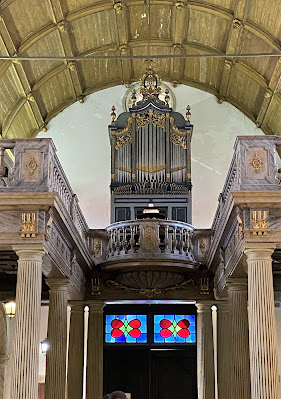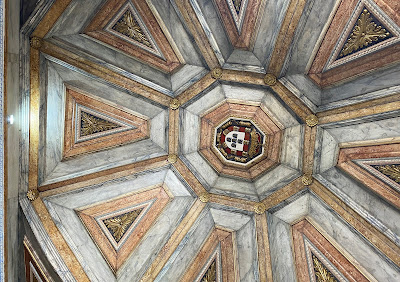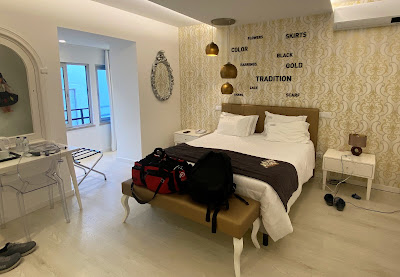June 26, 2022
There is a story that in the 4th century a small wooden statue of the Virgin Mary was brought from the city of Nazareth in the Holy Land to a monastery in Spain, and then in 711 it was brought to the Portuguese seaside by a monk and the current king of Portugal. They promptly became hermits, moving into a small grotto in the cliffs above the sea. When the monk died, the king left the Madonna statue on an altar in the grotto.
Flash forward 400+ years. As mentioned in my previous post, sometime in the 12th century a local official was chasing a deer during a hunt in the fog, and he chased the deer over a cliff near the grotto. Just as the hunter's horse was about to follow the deer, the hunter called out to the Virgin to save him, and, miraculously, his horse stopped abruptly on the very verge of a death drop.
To honor this miraculous intervention by the Virgin Mary, a chapel was built over the grotto in 1182. A bigger church that could accommodate more visitors to the Virgin was built in 1377 by King Fernando I, and it was remodeled multiple times between the 16th and 19th centuries. Today, this beautiful baroque Sanctuary of Our Lady of Nazaré still houses the miraculous statue. The name Nazaré (pronounced Na-zuh-RAY) is the Portuguese version of Nazareth, the city in the Holy Land from where the statue came.
Unfortunately, when we were there the statue itself was out for repair and restoration, but there was still a lot to enjoy in the rest of the church.
From the back of the altar, visitors can use a narrow walk to access a front view of the niche that usually holds the famous statue.
This zoomed in shot shows a woman about to walk past the statue niche.
My favorite place in the church was this small chapel with all the vibrant colors and twisted, curvy shapes.
A beautiful octagonal dome covers the chapel.
And, of course, there are more azulejos.
This was one of my favorite churches in Portugal.
It was time to check into our hotel, so we drove through a crazy maze of twisty-turny one-way streets, enjoying the architecture along the way . . .
. . . until we reached the Magic Hotel. We checked in and Bob promptly fell asleep for two hours.
 |
| Dolls in traditional dress in a glass cabinet in our room |
Of course, he woke up in time for us to make our reservation at Dos Ventos (Two Windows) Restaurant, a small place within a few blocks of our hotel (closer than the place the hotel had us park our car).
Nazaré, like most of the coastal cities of Portugal, is known for its seafood. At Dos Ventos, we could choose our fish from what had been caught during the day.
We try to eat early, both for our digestion and to beat the evening crowds. For a little while, at least, we had the restaurant to ourselves.
What a feast. We had cockle clams swimming is seasoned butter, boiled potatoes, a very good green salad, a basket of bread . . .
. . . and the catch of the day, a whole grouper cooked to perfection.
After dinner we walked across the grainy sand to Atlantic Ocean.


.JPG)






.jpg)
.JPG)

.JPG)
.JPG)
.JPG)






.JPG)













.JPG)
I have very fond feelings for Nazare. Perhaps I associate it a bit with the North Shore of Hawaii. Perhaps it is the open space and large beaches. It is a place I could go and spend some time to laze about.
ReplyDelete